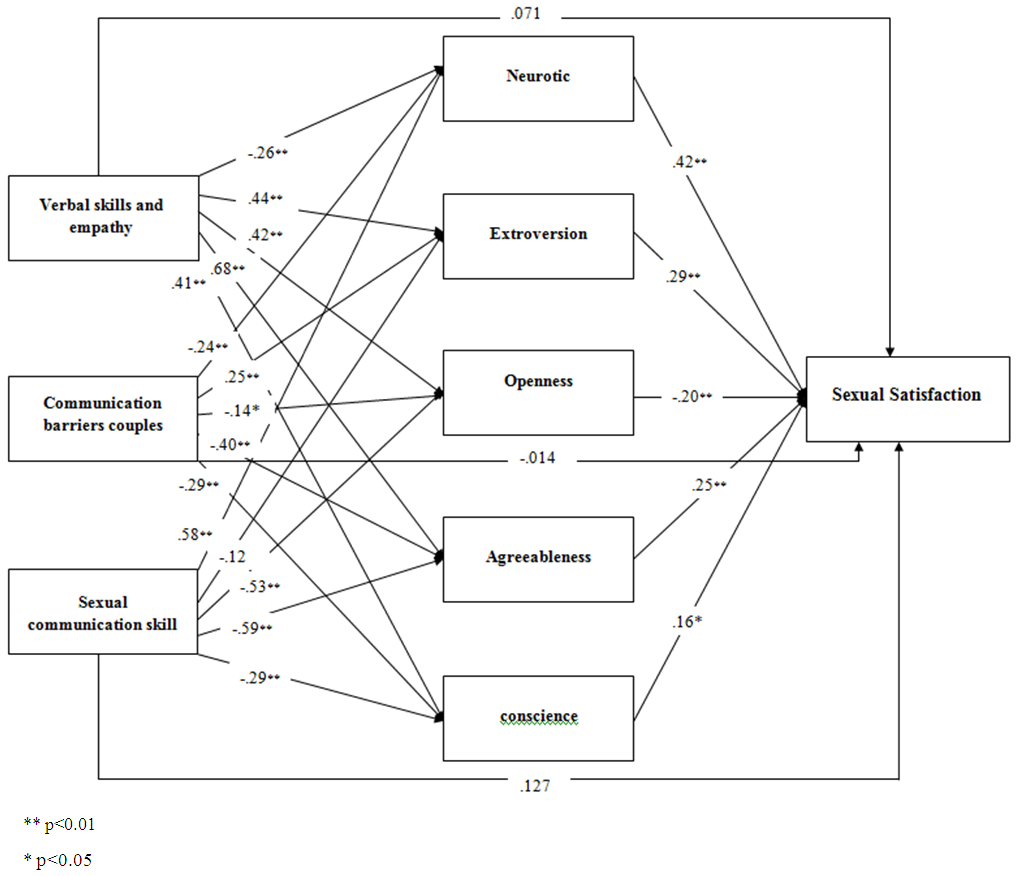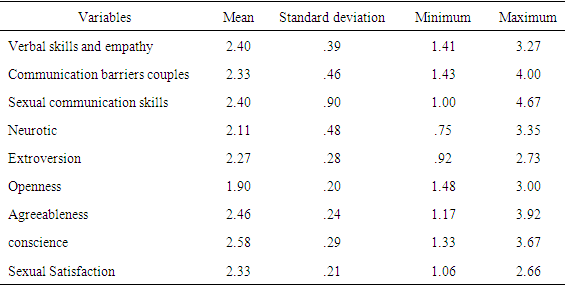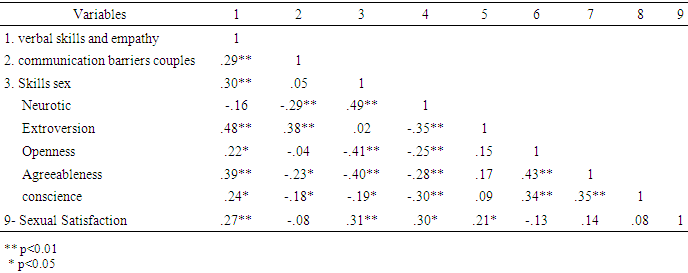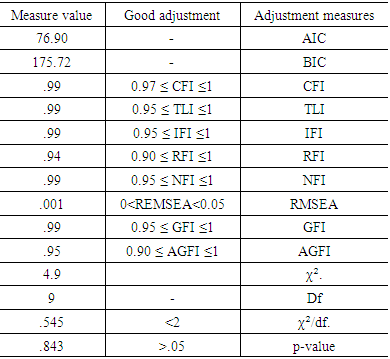-
Paper Information
- Next Paper
- Previous Paper
- Paper Submission
-
Journal Information
- About This Journal
- Editorial Board
- Current Issue
- Archive
- Author Guidelines
- Contact Us
International Journal of Psychology and Behavioral Sciences
p-ISSN: 2163-1948 e-ISSN: 2163-1956
2017; 7(3): 83-89
doi:10.5923/j.ijpbs.20170703.04

The Effect of Communication Skills on Sexual Satisfaction with the Mediatory Effect of Personality Traits among Individual Filing for Divorce in Shiraz
Ebrahim Ghanbari1, Fatemeh Akbari Zadeh2, Nooshafarin Amirazodi3, Alireza Alamgir Alam1
1Department of Psychology, Islamic Azad University, Marvdasht Branch, Marvdasht Iran
2Department of Psychology, Islamic Azad University, Fasa Branch, Fasa Iran
3Department of Psychology, Islamic Azad University, Arsanjan Branch, Arsanjan Iran
Correspondence to: Ebrahim Ghanbari, Department of Psychology, Islamic Azad University, Marvdasht Branch, Marvdasht Iran.
| Email: |  |
Copyright © 2017 Scientific & Academic Publishing. All Rights Reserved.
This work is licensed under the Creative Commons Attribution International License (CC BY).
http://creativecommons.org/licenses/by/4.0/

This study aimed to investigate the effect of communication skills on sexual satisfaction with the mediatory effect of personality traits among individual filing for divorce in Shiraz. A descriptive-correlation research design was used in this study. In addition, path analysis was used for modeling the research variables. The sample under study was selected randomly from people filing for divorce at Shiraz Family Court in the first seven months of 2014. The sample size based on the number of questionnaires distributed consisted of 115 divorce applicants. The instruments used to collect data were the NEO Five-Factor Inventory (NEO-FFI), Communication Skills Scale (Dastan et al., 2010), and Sexual Satisfaction Scale (Yavari Kermani, 2007). The collected data were analyzed using descriptive and inferential statistics by AMOS18. The results of path analysis showed that verbal skills and empathy have a positive impact on the respondents’ sexual satisfaction (β = 0.07, P > 0.05) but it is not significant. However, by mediation of personality traits, verbal skills and empathy have a positive significant impact on the respondents’ sexual satisfaction (β = 0.17, P < 0.01). In total, verbal skills and empathy have a positive significant impact on the respondents’ sexual satisfaction (β = 0.24, P < 0.05) and thus verbal skills can improve sexual satisfaction under the influence of personality traits. The findings of the study underline the necessity of paying attention to communication skills as an important principle and personality traits as one of the aspects of mental health.
Keywords: Communication skills, Personality traits, Sexual satisfaction, People filing for divorce
Cite this paper: Ebrahim Ghanbari, Fatemeh Akbari Zadeh, Nooshafarin Amirazodi, Alireza Alamgir Alam, The Effect of Communication Skills on Sexual Satisfaction with the Mediatory Effect of Personality Traits among Individual Filing for Divorce in Shiraz, International Journal of Psychology and Behavioral Sciences, Vol. 7 No. 3, 2017, pp. 83-89. doi: 10.5923/j.ijpbs.20170703.04.
1. Introduction
- The problem of divorce as a social harm has received widespread attention in recent years through the entire world including Iran and the number of divorce cases are increasing on a daily basis. The researchers cited several reasons for divorce, including sever ideological differences, personality differences, cultural differences, economic problems, gender and sexual differences, differences in the family, different upbringing, maladaptive personality traits, and the two sides insisting on their opinions may cause disagreement and tensions, leading to conflict and eventually to divorce (Ghorbani, 2005; Kurdek, 1993; Malouff, Thorsteinsson, Schutte, Bhullar & Rookke, 2010; Rodrigues, Hall, Buffalo & Fincham, 2007). Almost there is not man or woman who marries with the intention of getting divorce. However, developments in the couples’ life lead them to disagreement, conflict, mental and emotional separation, and sometimes divorce (Bahari, 2009). As it was mentioned, one of the reasons for divorce can be sexual needs. Sexual instinct is one of human inherent needs and is of high significance especially after marriage. Sexual instinct is important in the sense that sexual identity is formed at the age of 2-3 and remains stable until death to satisfy the need for survival and the continuance of comfort (Kajbaf, 2012). A satisfactory sexual relationship is necessary for a having a stable and satisfactory marital life. Sexual satisfaction is dependent on the mutual trust between the couples and doing one’s best to have a relationship based on respect at all times and not only in the bedroom. Such a relationship is the key for couples have more intimacy and closeness. Sleeping together joyfully is a major part of the satisfaction in the conjugal life. Satisfied couples remain sexually interested in each other as a satisfactory marital life is the most erogenous factor for couples (Glaser & Glaser, cited in Sahebi and Soltanifar, 2014). Sexual satisfaction includes two aspects: physical sexual satisfaction and emotional sexual satisfaction. The former includes sexual behaviors and desires while the latter covers intimacy and the quality of sexual relationships (Hudson, Harrison, & Krosscup, 1981, cited in Honarparvaran, 2009). In the 1970s and 1980s, most of the studies addressed sexual satisfaction regardless of the context and content of the sexual relationship and they considered the frequency of sexual intercourse and the frequency of reaching orgasm as the only important factor in sexual satisfaction. However, many believe that the frequency of intercourse and orgasm is only one of the aspects of sexual activity. Recent studies in several countries show that people do not equate sexual satisfaction with its physical aspects (frequency of intercourse and reaching orgasm) but the emotional aspect of sexual satisfaction is also important for them (Bridges & Lease, 2001; Elisson, 2004; Richter, 2003; cited in Honarparvaran, 2009). As was stated, sexual satisfaction does not include only the physical aspects and there is the possibility that several factors, including the couple's communication skills are also involved in it. One of the best ways to strengthen the relationships between couples is to teach communication skills to them as such skills help them to resolve their future marital conflicts (Yalsin & Karahan, 2007). Communication problems constitute a central issue in communications approaches. Family communication therapy theorists believe that conflicts often follow a vicious circle that any attempt made to find its starting point is useless as couples believe that whatever they say or do is a reaction to what the other party does and says (Goldenberg & Gildenberg, 2008; cited in Shahi Baravati, Naghshbandi, & Arjmand, 2013). Communication problems are among the most common problems expressed by couples. More than 90% of disturbed couples express communication problems as the most serious issue in their relations. Communication problems are regarded as a key issue in communication approaches to family. In these approaches, marital conflicts are seen as a maladaptive relation (Reza Zadeh, 2008). Therefore, as the research shows, one of the factors that improves the couple’s feeling of satisfaction and can contribute the higher rates of divorce is personality traits as a group of intrapersonal factors. Personality directly affects the relationship between the couple as well as their sexual satisfaction (Simon, 2003). Research also shows that people applying for divorce are different from each other in terms of personality traits (Shokrkon et al., 2006). Personality, according to Allport, is one of the most deep-rooted aspects of the human existence. Personality is a dynamic organization of physical and mental systems inside a person which determine his/her behaviors, thoughts, attitudes, and daily decisions (Schultz, cited in Karimi, 2012). Personality is not a simple and objective concept that can be easily defined, but it is an abstract concept or construct and this makes it too difficult to define (Roos, 2010). Five big personality factors and scales are: nervousness, emotional instability, openness, agreeableness, and conscientiousness (Costa & McCrae, 1992). It should be noted that each marriage is not perfect as in most of heath marriages there are some disagreements but the husband and wife solve them in a logical way. However, sometimes the emergence of frequent problems in the marital and family life can potentially threaten the institution of family and can pave the way for more problems in the family life (Sotudeh & Bahari, 2007). Marital conflict and divorce can cause great damage to the unity of the community. Given the importance of relations between couples and increased rate of conflict and divorce and the number couple referring to treatment, counseling, and psychology centers, the aim of this study is to identify some of the factors that lead to marital discord and divorce. Therefore, the present study is going to investigate the effect of communication skills on sexual satisfaction with the mediatory effect of personality traits among individual filing for divorce in Shiraz.
2. Method
- A descriptive-correlation research design was used in this study. In addition, path analysis was used for modeling the research variables. The sample under study was selected randomly from people filing for divorce at Shiraz Family Court in the first seven months of 2014. To ensure the homogeneity of the sample, the respondents were selected from those with a minimum age of 18 and a maximum age of 50, at least 7 years of education, and the marriage duration of 0 to 20 years. The sample size based on the number of questionnaires distributed consisted of 115 divorce applicants who were selected purposefully.
 | Figure 1. Path analysis model used in the study |
3. Instruments
- The NEO Five-Factor Inventory (NEO-FFI): A short version of NEO-FFI with 60 items was used to measure five personality traits (neuroticism, extraversion, openness to experience, agreeableness, and conscientiousness) based on a 5-point likert scale. According to Costa and McCrae (1992, cited in Haghshenas, 2014), the validity values for subscales of neuroticism, extraversion, and openness to experience were 0.68 to 0.83 in personal reports and couples’ self-reports. In addition, the validity values for agreeableness and conscientiousness were equal to 0.79 and 0.63 within a two year period (Costa & McCrae, 1992). Communication Skills Scale: This questionnaire was developed by Dastan, Rajabi, Khosh Konesh, and Khojaste Mehr (2010). The analysis of the main components of the questionnaire using Varimax rotation shows three factors of verbal skills and empathy, communication obstacles, and sexual communication skills. The questionnaire contains 32 multiple choice items (almost never, rarely, sometimes, almost often, and most of the times) which measure verbal skills and empathy, communication obstacles, and sexual communication skills. It should be noted that the value of Cronbach alpha for these three factors are equal to 0.94, 0.76, and 0.82. In addition, the total Cronbach alpha is 0.93. The corresponding reliability values for these factors are equal to 0.68, -0.22, and 0.63, respectively (Dastan et al., 2010). Sexual satisfaction Scale: This scale which assesses personal feelings and worries about love and sexual relationship with the partner was developed by Yavari Kermani (2007) and contains 17 items. The reliability of the scale was reported as 0.75 by Yavari Kermani (2007).
4. Results
- Table 1 shows mean, standard deviation, minimum and maximum for research variables including sexual satisfaction, communication skills, and subscales of personality traits:
|
 | Figure 2. Standardized effects of Structural Equation Model |
|
|
 | Table 4. The results of Path Analysis of the standardized effect of Communication Skill on Sexual Satisfaction with Personality Features |
5. Conclusions
- Divorce is a social problem that severely affects the people involved. Divorce not only results in the dissolution of marriage relations, but also leads to the disintegration of relationships between parents and children (Hetherington, 1989; cited in Rezai, 2007). As mentioned in the introduction of this study, the aim of this study was to investigate the effect of communication skills on sexual satisfaction with the mediatory effect of personality traits among individual filing for divorce in Shiraz. The findings of the study, as shown in Table 3, indicated that the indices confirm the model used under study and its fit. Therefore, the model has a good fit and shows that the relationship between the variables is based on a sound theoretical framework. This suggests that verbal skills and empathy by mediation of personality traits have a positive significant impact on the respondents’ sexual satisfaction. In addition, couples’ communication barriers by mediation of personality traits have a negative significant impact on the respondents’ sexual satisfaction. It was also noted that sexual communication skills by mediation of personality traits have a positive significant impact on the respondents’ sexual satisfaction. Considering the results of this study, it can be said little research is done on this problem. Besides, the results of this study are consistent with previous research (Ghanbari et al., 2014; Sheikhan et al., 2014; Edrisi et al., 2012; Movahed & Azizi, 2011, Bahreinian & Kermani, 2010, Behruzi, Motahari Rad, & Borumand Nasab, 2014, Ghehlaghi, 2014; Behruz, Mohammadi, Ali Abadi, Kajbaf, Heidarzadeh, & Behruz, 2014; Taghipur, Gholami Hezarvnd, Jafarzadeh, & Soltani 2014, D’ Zurilla, Olivares, & Pujol, 2011), Stroad, Durbin, Sargal, & Knobloch, 2010; Malouff, Thorsteinsson, Schutte, Bhull, & Rooke, 2010; and Dannellan, Conger, & Bryant, 2004). In explaining the results, it should be considered that divorce is one of phenomena which in addition to the family system involve the social system at different levels. Divorce is a process which starts with an experience of emotional crisis for both the husband and the wife and ends in attempting to resolve conflicts by entering into new situations, roles, and lifestyles. Thinkers and sociologists consider divorce as one of the most important social harms. The highest rate of divorce is a clear sign of disorder in ethics and the disruption of family comfort and generally changes in social norms. As it was mentioned earlier, communication skills cannot directly affect individuals’ sexual satisfaction but they do so by mediation of personality traits. In other words, communication skills influenced by personality traits can improve sexual satisfaction. Based on the finding that personality traits have played a significant role in this study it can be said that one of the disorders most frequently observed among people referring to courts as an important cause of divorce is paranoid personality disorder. This disorder which is characterized by mistrust in others and cynicism is seen as one of the factors causing problems in one’s relationship with others and is associated with mistrust in others. People suffering from paranoid see the external world as antithesis to them and have no trust in others. They always think that others are going to harm them or making conspiracy against them. Partners are not an exception. Being suspicious about the partner is one of the most prominent characteristics of such people. Such people are seriously interested in knowing all relationship their partners have with the world outside and they show serious sensitivity to all details of their partner’s relationship with family members, relatives, and friends. As a result, they try to have the highest level of control and supervision on their partner’s actions, behaviors, and relationships. Therefore, any ambiguous relationship by their partner can result in a strong feeling of anxiety and even danger inside such people (Yunesi, 2012). One of the problematic factors that can disturb the couple’s relations and lead to divorce is a person’s mental disorders in the past or in the present. Most cases of communication problems and divorce have been reported for people suffering from severe mental disorders, depression, and some anxiety-related disorders in a way that it can be said that marital conflicts and psychological disorders have a mutual impact on each other (Halford, cited in Tabrizi & Kardani, 2014). A poosible reason is that the divorce process usually starts with a friction or tension between the husband and the wife and such problems may arise due to the lack of communication skills followed by the development of emotional self-apathy leading to obvious and actual animosity. The next stage is thinking of divorce as a solution by one or both parties and disclosing marital problems to other people as confidants. It should also be mentioned that divorced people report different factors as the causes of their divorce and thus divorce is not always caused by a single problems as its causes are different in terms of couples’ conditions and characteristics. According to Mafposi, all marriages do not fail by similar causes. In addition, there is no single cause for the failure of a given marriage. Finally, as findings of this study indicated since personality traits are among important factors for couples and can affect their shared life, all family practitioners are recommended to determine personality traits of each couple and raise their awareness in this regard in premarital counseling sessions.
 Abstract
Abstract Reference
Reference Full-Text PDF
Full-Text PDF Full-text HTML
Full-text HTML

